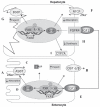Bile acid malabsorption in chronic diarrhea: pathophysiology and treatment
- PMID: 24199211
- PMCID: PMC3816948
- DOI: 10.1155/2013/485631
Bile acid malabsorption in chronic diarrhea: pathophysiology and treatment
Abstract
Background: Bile acid malabsorption (BAM) is a common but frequently under-recognized cause of chronic diarrhea, with an estimated prevalence of 4% to 5%.
Methods: The published literature for the period 1965 to 2012 was examined for articles regarding the pathophysiology and treatment of BAM to provide an overview of the management of BAM in gastroenterology practice.
Results: BAM is classified as type 1 (secondary to ileal dysfunction), type 2 (idiopathic) or type 3 (secondary to gastrointestinal disorders not associated with ileal dysfunction). The estimated prevalence of BAM is >90% in patients with resected Crohn disease (CD) and 11% to 52% of unresected CD patients (type 1); 33% in diarrhea-predominant irritable bowel syndrome (type 2); and is a frequent finding postcholecystectomy or postvagotomy (type 3). Investigations include BAM fecal bile acid assay, 23-seleno-25-homo-tauro-cholic acid (SeHCAT) testing and high-performance liquid chromatography of serum 7-α-OH-4-cholesten-3-one (C4), to determine the level of bile acid synthesis. A less time-consuming and expensive alternative in practice is an empirical trial of the bile acid sequestering agent cholestyramine. An estimated 70% to 96% of chronic diarrhea patients with BAM respond to short-course cholestyramine. Adverse effects include constipation, nausea, borborygmi, flatulence, bloating and abdominal pain. Other bile acid sequestering agents, such as colestipol and colesevelam, are currently being investigated for the treatment of BAM-associated diarrhea.
Conclusions: BAM is a common cause of chronic diarrhea presenting in gastroenterology practice. In accordance with current guidelines, an empirical trial of a bile acid sequestering agent is warranted as part of the clinical workup to rule out BAM.
HISTORIQUE :: La malabsorption de l’acide biliaire (MAB) est une cause de diarrhée chronique fréquente mais souvent sous-diagnostiquée, dont la prévalence est évaluée entre 4 % et 5 %.
MÉTHODOLOGIE :: Les chercheurs ont examiné les publications de 1965 à 2012 pour en extraire les articles portant sur la physiopathologie et le traitement de la MAB en gastroentérologie.
RÉSULTATS :: La MAB est divisée en type 1 (secondaire à une dysfonction iléale), type 2 (idiopathique) et type 3 (secondaire à des troubles gastro-intestinaux non associés à une dysfonction iléale). La prévalence estimée de la MAB dépasse les 90 % chez les patients ayant une résection causée par la maladie de Crohn (MC) et se situe entre 11 % et 52 % chez les patients atteints d’une MC sans résection (type 1). Elle correspond à 33 % en cas de syndrome du côlon irritable qui se manifeste surtout par de la diarrhée (type 2) et est fréquente après une cholecystectomie ou une vagotomie (type 3). Les examens incluent le titrage de l’acide biliaire fécale, de l’acide 23-séléno-25-homotauro-cholique (SeHCAT) et de la chromatographie à haute performance du sérum 7-α-OH-4-cholesten-3-one (C4) causés par la MAB, afin de déterminer le taux de synthèse de l’acide biliaire. En pratique, une solution moins chronophage et moins coûteuse consiste à procéder à un essai empirique de la cholestyramine, l’agent séquestrant des acides biliaires. On estime que de 70 % à 96 % des patients atteints de diarrhée chronique présentant une MAB répondent à un court traitement à la cholestyramine. Les effets indésirables incluent la constipation, les nausées, les borborygmes, les flatulences, les gonflements et les douleurs abdominales. D’autres agents séquestrants des acides biliaires, comme le colestipol et le colésévélam, sont en cours d’évaluation en vue du traitement de la diarrhée associée à la MAB.
CONCLUSIONS :: La MAB est une cause fréquente de diarrhée chronique en gastroentérologie. Conformément aux directives à jour, un essai empirique de l’agent séquestrant des acides biliaires s’impose dans le cadre du bilan clinique pour écarter la MAB.
Figures


References
-
- Talley NJ, Weaver AL, Zinsmeister AR, Melton LJ., III Onset and disappearance of gastrointestinal symptoms and functional gastrointestinal disorders. Am J Epidemiol. 1992;136:165–77. - PubMed
-
- Talley NJ, O’Keefe EA, Zinsmeister AR, Melton LJ., III Prevalence of gastrointestinal symptoms in the elderly: A population-based study. Gastroenterology. 1992;102:895–901. - PubMed
-
- Schiller LR. Diarrhea and malabsorption in the elderly. Gastroenterol Clin North Am. 2009;38:481–502. - PubMed
-
- Canadian Digestive Health Foundation Diarrhea information sheet. < www.cdhf.ca/pdfs/fact-sheets/CDHF_FactSheet_Diarrhea.pdf#zoom=100 > (Accessed August 15, 2012).
Publication types
MeSH terms
Substances
LinkOut - more resources
Full Text Sources
Other Literature Sources
Medical
Miscellaneous
